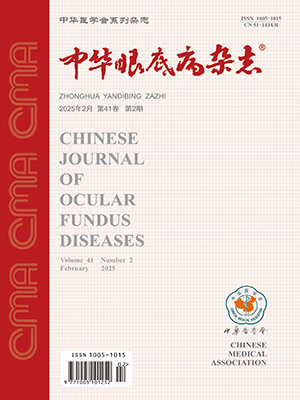| 1. |
Jacoba CMP, Salongcay RP, Aquino LAC, et al. Comparisons of handheld retinal imaging devices with ultrawide field images for determining diabetic retinopathy severity[J]. Acta Ophthalmol, 2023, 101(6): 670-678. DOI: 10.1111/aos.15651.
|
| 2. |
Li Z, Yuan Y, Qi Q, et al. Relationship between dyslipidemia and diabetic retinopathy in patients with type 2 diabetes mellitus: a systematic review and meta-analysis[J]. Syst Rev, 2023, 12(1): 148. DOI: 10.1186/s13643-023-02321-2.
|
| 3. |
Ahmmed MS, Shuvo SD, Paul DK, et al. Prevalence of dyslipidemia and associated risk factors among newly diagnosed type-2 diabetes mellitus (T2DM) patients in Kushtia, Bangladesh[J/OL]. PLOS Glob Public Health, 2021, 1(12): e0000003[2021-12-07]. https://pubmed.ncbi.nlm.nih.gov/36962092/. DOI: 10.1371/journal.pgph.0000003.
|
| 4. |
Yao L, Wang X, Zhong Y, et al. The Triglyceride-glucose index is associated with diabetic retinopathy in Chinese patients with type 2 diabetes: a hospital-based, nested, case-control study[J]. Diabetes Metab Syndr Obes, 2021, 14: 1547-1555. DOI: 10.2147/DMSO.S294408.
|
| 5. |
周卓琳, 毕春潮, 邵娟, 等. 血脂、血糖代谢水平及血压水平与糖尿病视网膜病变的相关性分析[J]. 实用临床医药杂志, 2020, 24(10): 49-52. DOI: 10.7619/jcmp.202010012.Zhou ZL, Bi CC, Shao J, et al. Analysis on correlations between blood lipid, blood glucose metabolic levels as well as blood pressure and diabetic retinopathy[J]. J Clin Med Pract, 2020, 24(10): 49-52. DOI: 10.7619/jcmp.202010012.
|
| 6. |
钱方方, 蔡珍生, 顾恬, 等. 2型糖尿病患者血清Ectodysplasin A与非酒精性脂肪性肝病相关性研究[J]. 中国全科医学, 2023, 26(8): 911-916. DOI: 10.12114/j.issn.1007-9572.2022.0660.Qian FF, Cai ZS, Gu T, et al. Relationship between Ectodysplasin A and nonalcoholic fatty liver disease in patients with type 2 diabetes mellitus[J]. Chin Gen Pract, 2023, 26(8): 911-916. DOI: 10.12114/j.issn.1007-9572.2022.0660.
|
| 7. |
中华医学会眼科学分会眼底病学组, 中国医师协会眼科医师分会眼底病学组. 我国糖尿病视网膜病变临床诊疗指南(2022年)——基于循证医学修订[J]. 中华眼底病杂志, 2023, 39(2): 99-124. DOI: 10.3760/cma.j.cn511434-20230110-00018.Fundus Disease Group of Ophthalmological Society of Chinese Medical Association Fundus Disease Group of Ophthalmologist Branch of Chinese Medical Doctor Association. Evidence-based guidelines for diagnosis and treatment of diabetic retinopathy in China (2022)[J]. Chin J Ocul Fundus Dis, 2023, 39(2): 99-124. DOI: 10.3760/cma.j.cn511434-20230110-00018.
|
| 8. |
林虹, 郑循达, 魏余琴, 等. 雅安市2型糖尿病患者血糖控制达标情况及其影响因素[J]. 华南预防医学, 2020, 46(6): 626-629. DOI: 10.12183/j.scjpm.2020.0626.Lin H, Zheng XD, Wei YQ, et al. Control rate of blood glucose and its influencing factors in type 2 diabetes mellitus patients in Ya’an City[J]. South China J Prev Med, 2020, 46(6): 626-629. DOI: 10.12183/j.scjpm.2020.0626.
|
| 9. |
Marie L, Al-Dabbas M, Khatatbeh A, et al. Importance of early spotting of diabetic retinopathy in type 2 diabetes patients by family medicine physicians and ophthalmologists: a study in Jordan[J/OL]. Cureus, 2023, 15(1): e34342[2023-01-29]. https://pubmed.ncbi.nlm.nih.gov/36865959/. DOI: 10.7759/cureus.34342.
|
| 10. |
Imai CC, Li L, Hardie RA, et al. Adherence to guideline-recommended HbA1c testing frequency and better outcomes in patients with type 2 diabetes: a 5-year retrospective cohort study in Australian general practice[J]. BMJ Qual Saf, 2021, 30(9): 706-714. DOI: 10.1136/bmjqs-2020-012026.
|
| 11. |
Priya S, Begum N. Correlation of lipid profile with duration of diabetes and HbA1c levels in type 2 diabetes mellitus patients: a descriptive cross-sectional study[J]. SBV J Basic Clin Appl Health Sci, 2020, 3(1): 19-22. DOI: 10.5005/jp-journals-10082-02234.
|
| 12. |
郭文娟. 2型糖尿病糖化血红蛋白与血脂检验意义研究[J]. 糖尿病新世界, 2022, 7(58): 58-61. DOI: 10.16658/j.cnki.1672-4062.2022.07.058.Guo WJ. Study on the significanceof glycatedHemoglobinand blood lipid test in type 2 diabetes mellitus[J]. Diabetes New World, 2022, 7(58): 58-61. DOI: 10.16658/j.cnki.1672-4062.2022.07.058.
|
| 13. |
Yang QH, Zhang Y, Zhang XM, et al. Prevalence of diabetic retinopathy, proliferative diabetic retinopathy and non-proliferative diabetic retinopathy in Asian T2DM patients: a systematic review and meta-analysis[J]. Int J Ophthalmol, 2019, 12(2): 302-311. DOI: 10.18240/ijo.2019.02.19.
|
| 14. |
Qummar S, Khan FG, Shah S, et al. Deep learning techniques for diabetic retinopathy detection[J]. Curr Med Imaging, 2020, 16(10): 1201-1213. DOI: 10.2174/1573405616666200213114026.
|
| 15. |
Kowluru RA. Diabetic retinopathy and NADPH oxidase-2: a sweet slippery road[J]. Antioxidants (Basel), 2021, 10(5): 783. DOI: 10.3390/antiox10050783.
|
| 16. |
Tabl M. Early detection of neurodegeneration in type 2 diabetic patients without diabetic retinopathy using electroretinogram and spectral-domain optical coherence tomography[J]. J Egypt Ophthalmol Soc, 2020, 113(1): 26-32. DOI: 10.2337/db16-1453.
|
| 17. |
Wasfi EI, Soliman EN, Mohammed RM, et al. Changes in retinal nerve fiber layer thickness after panretinal photocoagulation in diabetic retinopathy[J]. Egypt Retina J, 2020, 7(2): 36-40. DOI: 10.4103/erj.erj_12_20.
|
| 18. |
尹玉如, 焦万珍, 赵博军. 糖尿病患者视网膜神经组织变性及微血管损伤研究[J]. 中华眼底病杂志, 2022, 38(1): 27-33. DOI: 10.3760/cma.j.cn511434-20210730-00409.Yin YR, Jiao WZ, Zhao BJ. Study on retinal neurodegeneration and microvascular lesions in diabetic patients[J]. Chin J Ocul Fundus Dis, 2022, 38(1): 27-33. DOI: 10.3760/cma.j.cn511434-20210730-00409.
|
| 19. |
许亚静, 高健, 刘伦. 相干光层析眼底血管成像术对糖尿病视网膜病变临床前期检测的临床研究[J]. 临床眼科杂志, 2020, 28(4): 308-311. DOI: 10.3969/j.issn.1006-8422.2020.04.005.Xu YJ, Gao J, Liu L. Clinical study of optical coherence tomography angiography (OCTA) for preclinical detection of diabetic retinopathy[J]. J Clin Ophthalmol, 2020, 28(4): 308-311. DOI: 10.3969/j.issn.1006-8422.2020.04.005.
|
| 20. |
王海燕, 张永红. 糖尿病微血管病变发病机制研究进展[J]. 河北医科大学学报, 2024, 45(5): 585-589. DOI: 10.3969/ji.ssn.1007-3205.2024.05.016.Wang HY, Zhang YH. Research progress on pathogenesis of microvascular disease in diabetes[J]. J Hebei Med Univ, 2024, 45(5): 585-589. DOI: 10.3969/ji.ssn.1007-3205.2024.05.016.
|
| 21. |
路艳艳, 杨丽, 孙小艺, 等. 血糖控制对NDR期2型糖尿病患者视网膜神经纤维层厚度的影响[J]. 中国实验诊断学, 2022, 26(7): 971-975. DOI: 10.3969/j.issn.1007-4287.2022.07.007.Lu YY, Yang L, Sun XY, et al. Effect of blood glucose control on the thickness of retinal nerve fiber layer in type 2 diabetes patients at NDR stage[J]. Chin J Lab Diagn, 2022, 26(7): 971-975. DOI: 10.3969/j.issn.1007-4287.2022.07.007.
|




